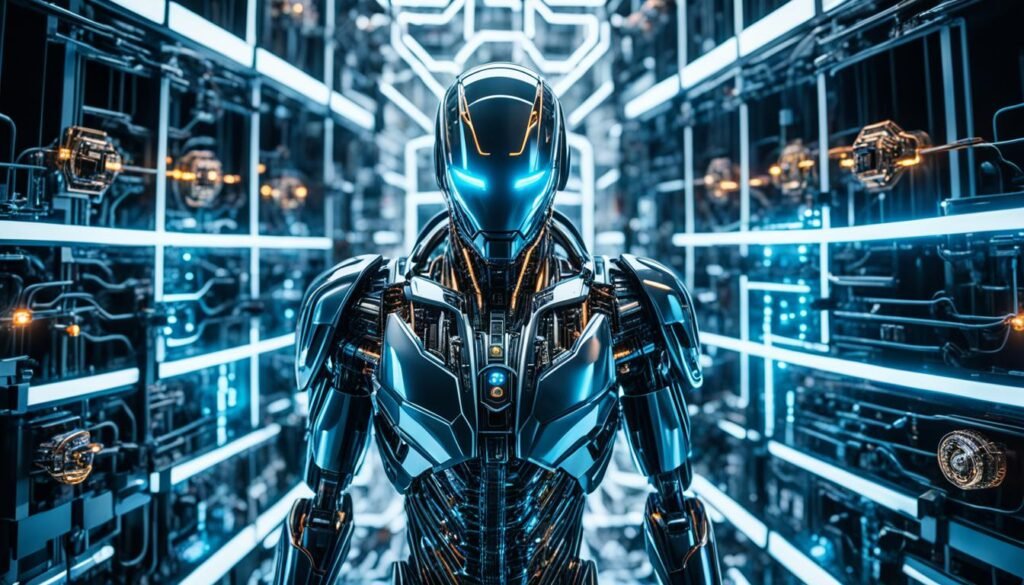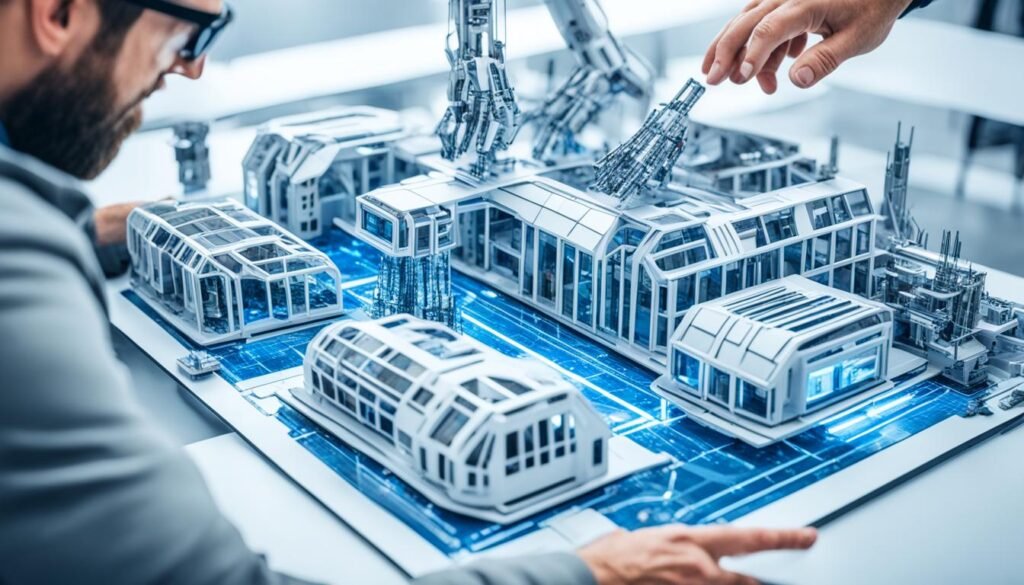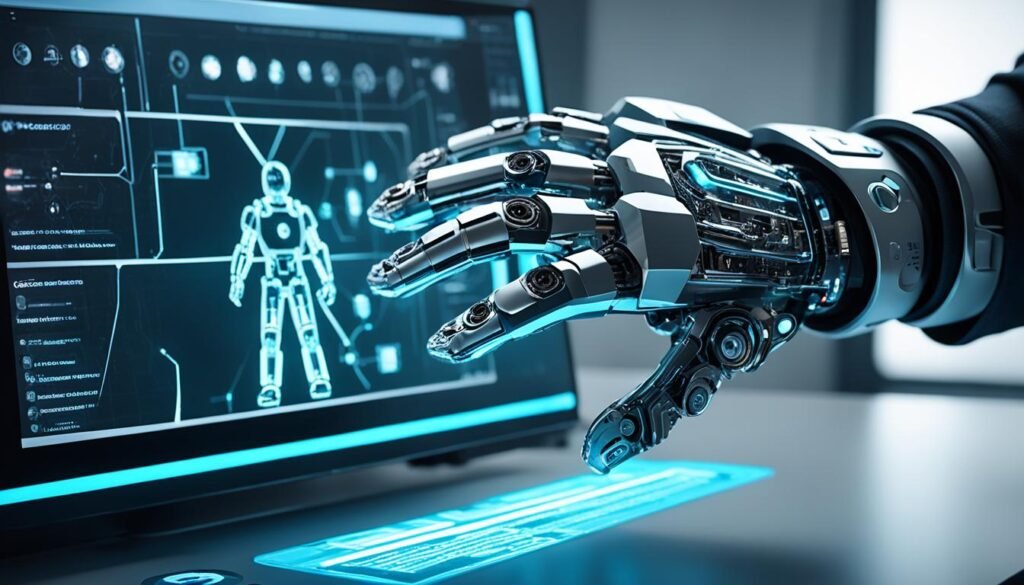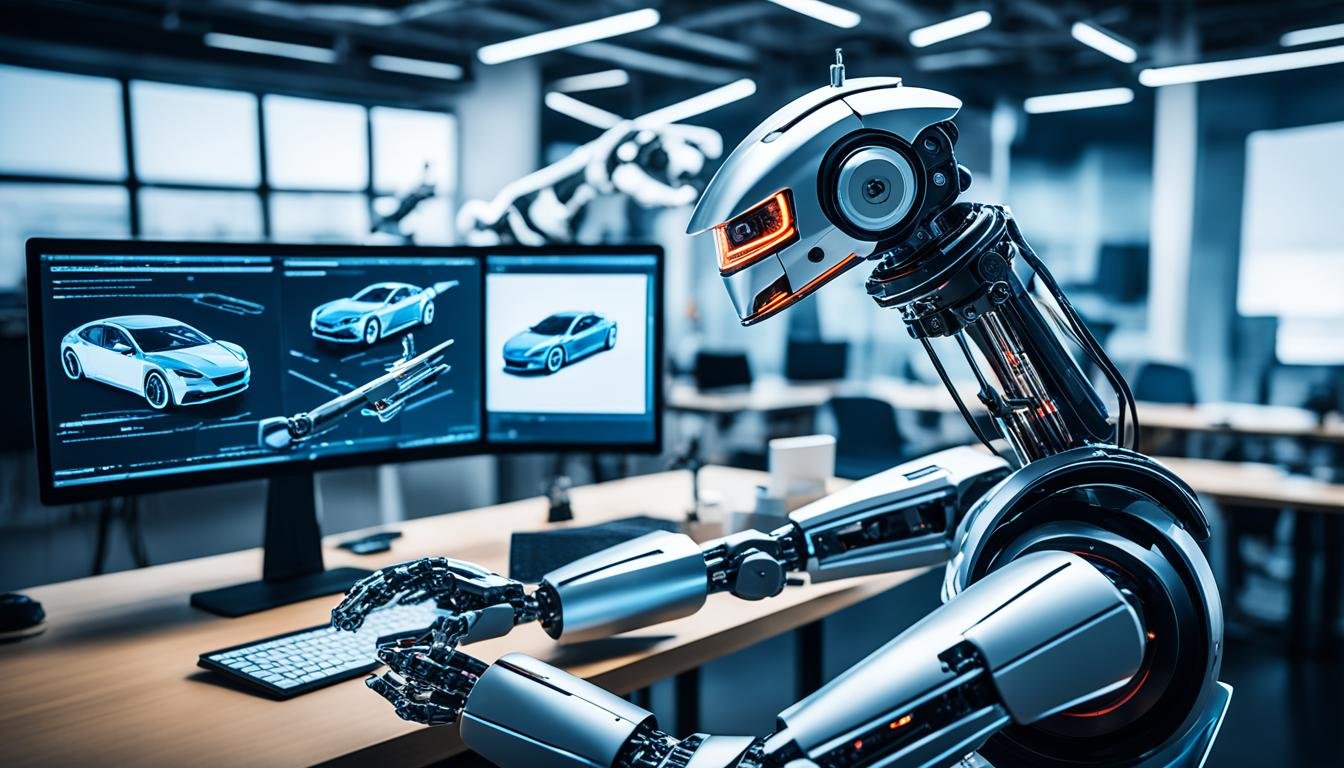AI-generated art is taking the world by storm, making us wonder: Will AI take over traditional 3D modeling tools like 3ds Max? With AI advancing fast, the future of 3D modeling is uncertain. We’ll look into how AI is changing 3D modeling, focusing on its abilities and how it might change our work in digital art, architecture, and product visuals.
Key Takeaways
- AI is changing the 3D modeling world, making it faster, better, and more efficient.
- AI tools can make 3D models, create real-looking images, and help with many tasks.
- AI won’t fully replace 3D artists, but it will change their work for the better.
- AI in 3D modeling is getting better fast, pushing traditional tools to keep up.
- Adding AI to 3D software is making work easier and more efficient.
Introduction to AI in 3D Modeling
AI is changing the game in visual creation fast. It’s making 3D modeling better with new tools and techniques. This is changing how we think about creativity.
What is AI and how does it work?
AI makes machines think like humans by learning and making decisions. In 3D modeling, it uses special algorithms to do tasks like making 3D shapes and making images look real.
The rise of AI tools for creative industries
AI has changed the game for 3D modeling and animation. In the last two years, AI tools have made a big impact. They help with everything from turning text into 3D models to making 3D modeling easier.
| AI Tool | Key Features | Applications |
|---|---|---|
| Midjourney | Text-to-image generation, image enhancement | Creative content creation, architectural visualization |
| DALL-E 2 | Photorealistic image generation from text descriptions | Product design, food and fashion photography |
| Stable Diffusion | Highly customizable AI-generated images | Concept art, 3D asset creation |
These AI tools are changing the creative world. They let artists and designers try new things, work faster, and express themselves in new ways.
AI’s Capabilities in 3D Modeling
AI has changed the game in creative fields, helping artists and architects explore new areas in 3D modeling and visualization. It can make 3D models and photorealistic images, changing the game in 3D design.
Can AI Generate 3D Models?
AI tools like Midjourney, DALL-E 2, and others are changing how we create. An artist used Midjourney to make 3D models from pictures, showing what AI can do. These tools use machine learning to study styles and make new designs, making creativity and work easier.
Can AI Create Photorealistic Images of Architectural Designs?
AI is a big help in architecture, making images that look real for brainstorming and early designs. Tools like AutoDesk’s 3ds Max Light Assistant and Unity’s Lightmapping with AI set the right lighting automatically, making designs look better.
Can AI Create Photorealistic Images of Food or Products?
AI isn’t just for architecture; it’s also great for showing food and products in 3D. Tools like GauGAN and Material Maker make textures and shaders automatically, making CGI work easier. Tools like GANPaint Studio and AutoDesk’s 3ds Max Populate add realistic objects and plants to scenes, making them look more real.
As AI gets better, it will change how we work in 3D modeling. It will let artists, architects, and designers do more in the digital world.

will ai replace 3ds max
The rise of artificial intelligence (AI) has made people wonder if it will change 3D modeling software like 3ds Max. As AI gets better, we’re talking more about if these tools will take over or work alongside traditional 3D methods.
AI in 3D modeling is great at making concept art and 3D models super fast. Tools like Midjourney can create many versions from just text, helping artists try out ideas quickly. This means faster turnaround times and more options for clients.
AI-generated 3D models are also getting better, like DreamFusion turning text into 3D shapes. This could make 3D modeling easier and quicker, saving time and effort.
But, the story of 3ds Max and other 3D tools isn’t just about replacing people. AI can also help 3D artists and architects do their jobs better. Features like smart image upscaling and denoising make 3D visuals better and faster.
As things change, we’ll see more AI in 3D modeling. The key is to balance AI’s power with human creativity. This way, AI helps 3D pros, not replace them.
The debate about 3ds Max and 3D modeling isn’t just AI versus humans. It’s about how AI and humans can work together. As AI gets better, the 3D world will need to find the best way to use AI. This will help keep the special touch that human artists add.
“The integration of AI into 3D modeling workflows will likely become more prevalent, but the challenge lies in finding the right balance between human creativity and the automation capabilities of AI.”
AI as an Assistive Tool for 3D Artists
AI is changing the game in 3D modeling. It helps 3D artists work smarter and faster. Instead of taking over, AI boosts their skills, making their designs more efficient and creative.
Concept Development and Client Visualization
AI is key in the early stages of design. With AI-powered tools for 3D concept generation, artists can quickly try out many ideas. They can then show their clients striking concepts, saving time and encouraging creativity.
AI-enhanced client visualization also lets artists make images and animations that look real. This helps clients understand and connect with the designs better. It’s a big step forward, making teamwork and decision-making smoother.
Reference Gathering and Portfolio Enhancement
AI is a big help in finding references. AI-driven image and video retrieval makes it easy to find the right visual inspiration. This leads to designs that are more informed and cohesive.
AI can also make 3D artists’ portfolios shine. By doing tasks like making realistic images or animations, AI helps artists show off their work better. This makes their portfolios more attractive and effective.
As AI becomes more common in 3D modeling, it’s clear it’s a powerful ally for artists. It helps them make designs that are not just efficient but also innovative and visually stunning.

The Role of AI in Architecture
The field of architecture is changing fast, and AI in architecture is a big part of that change. AI helps from the start, in sketching and idea-making, to making tasks more efficient. It’s changing how architects do their work.
Sketching and Ideation
AI is changing the creative process for architects. It helps with sketching and idea-making, letting architects come up with new designs quickly. AI uses learning algorithms to make realistic pictures and try out many designs. This lets architects make their ideas come to life faster.
Task Delegation and Optimization
AI is also changing how architects manage their work. It can do repetitive tasks, giving architects more time for important design decisions. Plus, AI can make building designs better, making them use less energy, be stronger, and follow rules. This makes architectural projects better overall.
| AI Application | Benefits |
|---|---|
| AI-powered sketching and ideation | Accelerated generation of innovative design concepts and photorealistic renderings |
| AI-driven task delegation and optimization | Automation of repetitive tasks, optimization of building designs, and enhanced workflow efficiency |
As AI in architecture grows, architects need to use these new tools wisely. They should keep their creative skills sharp while using technology to help. This way, architecture can reach new heights in design, teamwork, and solving problems. It will shape the future of our buildings.
Human Creativity vs. AI
AI is getting better in 3D modeling and design, but human creativity is still key. AI helps with many tasks, but it can’t match the spark of imagination and originality in top 3D work.
The Importance of Creativity, Intent, and Imagination
Great 3D modeling and design start with a spark of creativity only humans can light. AI uses past data to learn, but it can’t truly innovate. Humans, on the other hand, can come up with new ideas and add their own intent and style.
AI’s Limitations in Complex Technical Assignments
AI is great at repetitive tasks and processing data, but it can’t replace human skill in complex tasks. Things like 3D simulations and visual effects need a deep understanding AI hasn’t yet mastered. Humans are still vital for these tasks, thanks to their problem-solving skills and craft expertise.
The future of 3D modeling and design will blend human creativity with AI tech. This combo will open new doors and expand what we can do digitally. But, the human touch, with its unmatched imagination and intent, will keep being key to creating the most compelling 3D works.

| Human Creativity | AI Capabilities |
|---|---|
| Originality and Prediction | Learning from Existing Data |
| Intuitive Problem-Solving | Repetition and Optimization |
| Mastery of Craft and Nuance | Limitations in Complex Technical Assignments |
The Future of AI in 3D Modeling
AI is changing the 3D modeling industry. As AI gets better, we’ll see big changes in how 3D artists and architects work. They will use AI to make their projects better.
AI Integration into Workflows
AI will change the 3D modeling workflow a lot. It can do repetitive tasks, make the creative process smoother, and make projects more efficient. AI will help with making 3D models and making them look better.
Virtual Reality and AI-Powered Presentations
Virtual reality (VR) is making AI in 3D modeling even more exciting. AI can make 3D presentations more real and interactive. This means clients can see and interact with 3D models in a new way. It will change how we share and talk about 3D designs, making decisions easier and improving teamwork.
| Feature | Potential Benefit |
|---|---|
| AI-Generated 3D Models | Increased speed and efficiency in the 3D modeling process |
| AI-Powered Rendering Optimization | Improved rendering quality and reduced processing time |
| AI-Enhanced Virtual Reality Experiences | More immersive and engaging client presentations |
The future of 3D modeling is exciting, thanks to AI. AI will help 3D artists and architects be more creative and work better together. This will shape the future of this fast-changing field.
Ethical Considerations and Challenges
AI is getting more common in 3D modeling. It’s important to think about the ethical sides of using it. Issues like copyright, intellectual property, and balancing AI with human creativity need careful thought.
Copyright and Intellectual Property Issues
Using AI in 3D modeling raises concerns about copyright and intellectual property. Questions come up about who owns the final product. Designers and artists must make sure their work is safe and AI doesn’t take away their rights.
Balancing Automation and Human Creativity
AI can make 3D modeling easier, but we must keep a balance. It should help artists, not replace them. Designers need to use AI in a way that boosts creativity and helps them grow professionally.
There are also issues like bias, transparency, and accountability with AI in 3D modeling. Designers should use AI that is fair, clear, and fits their values. Keeping AI systems trained and checked is key to ethical use in the industry.

“The integration of AI in 3D modeling should be a collaborative effort, where human expertise and creativity are empowered, not replaced.”
As 3D modeling changes, it’s up to designers, artists, and others to tackle the ethical challenges of AI. Finding a balance between tech and human values will help the industry use AI ethically and fully.
Industry Perspectives
The world of 3D modeling is changing fast, and experts are watching how AI changes their work. From 3D artists and architects to industry experts, many have strong views on using AI in 3D modeling.
A recent survey shows that the archviz community is getting more comfortable with AI. About 12.29% say they’re very familiar with it, and 23.73% say they’re somewhat familiar. Also, more people are using AI tools in their work, with 72.88% reporting they’ve used them.
People’s experience with AI in archviz is mixed. They gave it an average score of 5 out of 10. They like how it speeds things up (66.30%) and makes work more efficient (46.41%). It also helps with creativity (44.75%). But, they worry about inconsistent results (76.80%), too much trial and error (59.12%), and not having control over the final product (58.01%).
| Familiarity with AI in Archviz | Adoption of AI Tools | Overall Experience with AI |
|---|---|---|
| Extremely familiar: 12.29% Very familiar: 23.73% Somewhat familiar: 47.03% |
72.88% have used AI tools | Average score: 5 out of 10 |
Despite the challenges, experts are hopeful about AI’s future in 3D modeling. Gartner predicts that by 2030, 75% of decisions will be made with AI’s help. This shows how big a change AI could bring. As experts find new ways to use AI, they see it making their work faster, more efficient, and creative.
“Generative AI possesses the potential to reshape how knowledge workers and subject matter experts interact with data and operational processes.”
Conclusion
As we wrap up our look at AI’s role in 3D modeling, it’s clear that the future is exciting. AI will work alongside human creativity, not replace it. Experts believe AI will boost the skills and work efficiency of architects and 3D artists.
AI tools like generative design and cloud collaboration are changing 3D modeling. They automate simple tasks and give designers more options. This lets pros focus on complex, creative challenges. With technology advancing, 3D modeling will get more efficient, collaborative, and beautiful.
But, adopting AI brings up ethical questions. Issues like copyright, intellectual property, and balancing automation with creativity need to be addressed. As 3D modeling changes, it’s important for professionals to keep up, adapt, and lead in shaping their future.
FAQ
What is AI and how does it work?
AI stands for artificial intelligence. It’s a part of computer science that aims to make systems do tasks that humans usually do, like seeing, understanding language, making decisions, and solving problems. AI uses machine learning to look at data and find patterns. This lets it predict and act without being told exactly what to do.
How are AI tools being used in the creative industries?
AI tools have changed the creative world, including 3D modeling and animation. Now, AI software can make, change, and improve 3D content. This makes it easier and faster for artists and designers to create top-notch visuals.
Can AI generate 3D models?
Yes, AI tools can make 3D models from text or images. These models can be a starting point for 3D artists or used as standalone assets in projects.
Can AI create photorealistic images of architectural designs, food, or products?
Absolutely. AI can now make very detailed, real-looking pictures of buildings, food, and products. This tech is getting better, making visuals that look just like real photos.
Will AI replace the 3ds Max software?
AI is getting better in 3D modeling and animation, but it won’t replace 3ds Max. AI is best as a tool to help 3D artists. It can make some tasks easier, but it can’t replace the creativity and skill of artists.
How can AI be used as an assistive tool for 3D artists?
AI can help 3D artists a lot. It can make tasks like developing concepts, showing clients ideas, finding references, and improving portfolios easier. By doing some tasks automatically, AI lets artists focus more on being creative and technical.
How can AI be used in the field of architecture?
AI is becoming a big part of architecture, helping with sketching, thinking of ideas, assigning tasks, and making workflows better. AI tools can help architects at the start of a project and with managing tasks and delegating work.
What are the limitations of AI in 3D modeling and design?
AI has made big steps in 3D modeling and design, but it can’t fully match human creativity, intent, and imagination. It also struggles with complex tasks that need a lot of skill and problem-solving.
What are the ethical considerations surrounding the use of AI in the 3D modeling industry?
Using AI in 3D modeling brings up big ethical questions, like copyright and intellectual property issues. It’s important to keep a balance between using AI and keeping human creativity and skill in the field.
What are industry professionals saying about the impact of AI on the 3D modeling industry?
People in the industry, like 3D artists and architects, have different views on AI’s effect on 3D modeling. Some see AI as a great tool that can make work easier and more creative. Others worry about AI replacing jobs and the need to keep a balance between AI and human skills.
